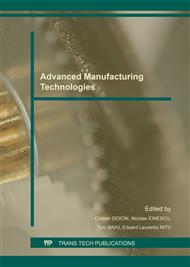[1]
J. Dawes, M. Thomas, Friction Stir Process Welds Aluminium Alloys, Welding Journal (1996) 31-45.
Google Scholar
[2]
S. Kakarla, K. Muci-Kuchler, W. Arbegast, C. Allen, Three - Dimensional Finite Element Model of the Friction Stir Welding Process, Proceeding of Friction StirWelding and Processing 3 (2005) 213-220.
DOI: 10.4271/2005-01-1260
Google Scholar
[3]
M. Awang, V. Mucino, Z. Feng, S. David, Thermo-Mechanical Modelling of Friction Stir Spot Welding (FSSW), SAE World Congress (2006).
DOI: 10.4271/2006-01-1392
Google Scholar
[4]
M. Awang, Simulation of Friction Stir Spot Welding (FSSW) Process: Study of Friction Phenomena, Dissertation, College of Engineering and Mineral Resources at West Virginia University, (2007).
Google Scholar
[5]
Y. Chao, X. Qi, Thermal and Thermo-Mechanical Modelling of Friction Stir Welding of Aluminium Alloy 6061-T6, Journal of Materials Processing & Manufacturing Science 7 (1998) 215-233.
DOI: 10.1106/ltkr-jfbm-rgmv-wvcf
Google Scholar
[6]
G. Johnson, W. Cook, A Constitutive Model and Data for Metals Subjected to Large Strains, High Strain Rates and High Temperatures, International Symposium On Ballistics 7 (1983) 1-7.
Google Scholar
[7]
G. R. Johnson, W.H. Cook, Fracture Characteristics of Three Metals Subjected to Various Strains, Strain Rates, Temperatures and Pressures, Engineering Fracture Mechanics 21 (1985) 31-48.
DOI: 10.1016/0013-7944(85)90052-9
Google Scholar
[8]
F. Al-Badour, M. Nesar, S. Abdelrahman, A. Bazoune, Thermo-mechanical finite element model of friction stir welding of dissimilar alloys, International Journal of Advanced Manufacturing Technology 72 (2014) 607-617.
DOI: 10.1007/s00170-014-5680-3
Google Scholar
[9]
A. Adibi-Sedeh, V. Madhavan, B. Bahr, Extension of Oxley's Analysis of Machining to use Different Material Models, Transactions of the ASME (2003) 656-666.
DOI: 10.1115/1.1617287
Google Scholar
[10]
M. Khandkar, J. Khan, A. Reynolds, Input Torque Based Thermal Model of Friction Stir Welding of Al-6061, Proceeding of the 6th International Trends in Welding Research Conference Proceeding, Pine Mountain (2001).
DOI: 10.1179/136217103225010943
Google Scholar
[11]
M. Assidi, L. Fourment, S. Guerdoux, T. Nelson, Friction model for friction stir welding process simulation: Calibrations from welding experiments, International Journal of Machine Tools & Manufacture 50 (2010) 143-155.
DOI: 10.1016/j.ijmachtools.2009.11.008
Google Scholar
[12]
M. Grujicic, G. Arakere, H.V. Yalavarthy, T. He, C.F. Yen, B.A. Cheeseman, Modeling of AA5083 Material-Microstructure Evolution During Butt Friction-Stir Welding, Journal of Materials Engineering and Performance 19(5) (2010) 672-684.
DOI: 10.1007/s11665-009-9536-1
Google Scholar
[13]
S. Mandal, J. Rice, A.A. Elmustafa, Experimental and numerical investigation of the plunge stage in friction stir welding, Journal of materials processing technology 203 (2007) 411-419.
DOI: 10.1016/j.jmatprotec.2007.10.067
Google Scholar
[14]
W. Li, Z. Zhang, J. Li, Y.J. Chao, Numerical Analysis of Joint Temperature Evolution During Friction Stir Welding Based on Sticking Contact, Journal of Materials Engineering and Performance 21(9) (2012) 1849-1856.
DOI: 10.1007/s11665-011-0092-0
Google Scholar
[15]
P. Su, A. Gerlich, T. North, G. Bendzsak, Energy Utilization and Generation during Friction Stir Spot Welding, Science and Technology of Welding and Joining (2006) 163-169.
DOI: 10.1179/174329306x84373
Google Scholar


